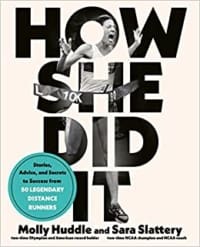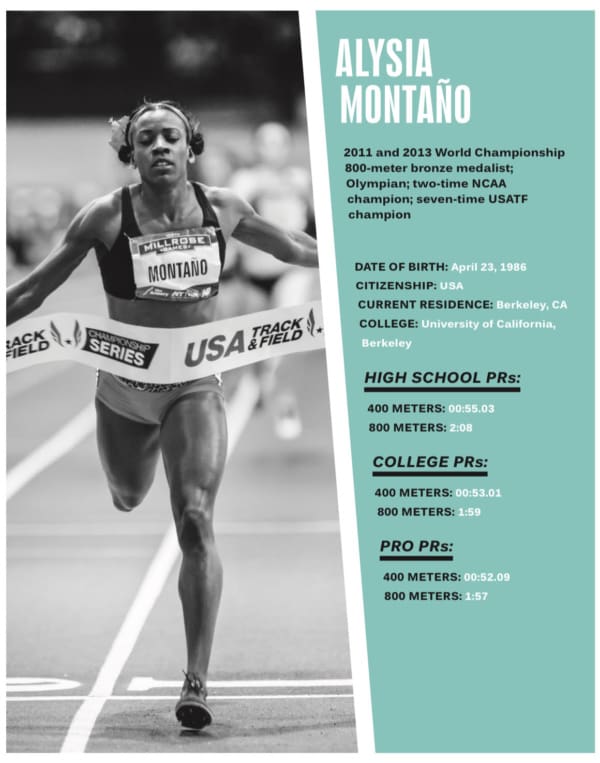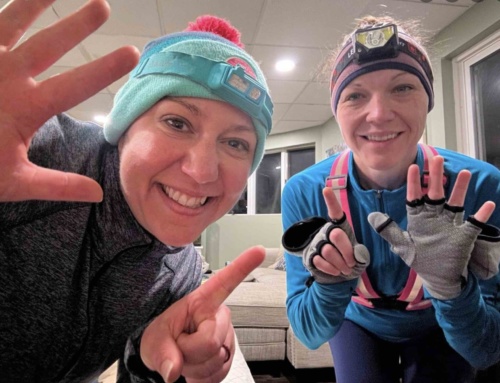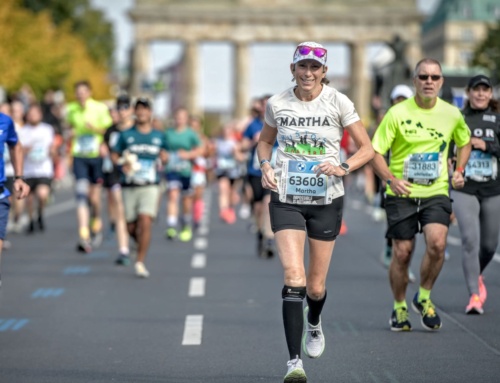
We’re thrilled to give you a peek inside How She Did It, a brand-new running book you’ll want to add to your bookshelf and file under M for Motivation. How She Did It is a compilation of stories from 50 legendary female distance runners—from Molly Seidel to Joan Benoit Samuelson and Shalane Flanagan—with the lessons and wisdom they learned after years of training. The piece we’re sharing here is from mother runner Alysia Montaño.
Be sure to tune in to the AMR Podcast on Friday, when Sarah interviews co-author Molly Huddle to discuss the book in detail.
FROM FAMILY SPORTS TO OLYMPIC DREAMS
Getting into running was a very innate thing. I did sports across the board. I played soccer and basketball, but also my family made sports games. They were a part of every family function—a swim meet, family flag football, a family basketball game, or a family soccer game. That’s how sports in general started for me. It was very much about play.
My high school coach talked me into cross-country. I was really good friends with his son Justin, who passed away the summer going into high school. He said, “Justin would have loved to run cross-country with you.” I had a really good time with the cross-country team. I liked the camaraderie. Even though it wasn’t my favorite sport, it reminded me of what I had with my family. I went straight to soccer after that. I loved keeping soccer in there because I just needed that. To this day I don’t really identify solely as a runner—I like to call myself an athlete.
SMILING TO A STATE TITLE
In high school, I ended up at the state track meet freshman year. It was the first time I ran two rounds of the 800 and I was like, Wait a minute. We’ve been running one race this entire season. I’m going to run again tomorrow? I took on the challenge, but I didn’t do that great. I think I was near last. The next year I finished higher up, like sixth or so, then fourth the next year.
I really wanted to win my senior year. I was doubting if I was ready. My coach said, “You can totally do this.” Sensing my nerves, he told me, “When you come around in the first 100, look over at us and smile. We’ll be there again on the backstretch. And if you need to do it again, smile again.”
I was in second to last place. My coach said, “That’s a fine spot. You can see everyone!” I slowly caught people, realized I was having fun out there, and then, with 100 meters to go, I found myself in the front
BECOMING A FRONTRUNNER
One of the challenges I’ve overcome is not trying to fit in a box of what a runner should be and needed to be in order to be good. In college, I ended up specializing in the 800, and I didn’t love how I was running the event. Tactically, everybody runs in a group together, and then everybody just kicks with 200 to go and it’s a last- person- standing kind of deal. I felt like I had a ton of energy at the end.
I mentioned this to my cousin, and he said, “Well, why don’t you go out faster?” I was like, You don’t understand the 800 . . . Wait. Why don’t I?!
I feel like I had to recognize and pull out my strengths. It was then I recognized I don’t need to fit in a box. Maybe my strength in the 800 is going to be me changing the game on how to run the race so that I have the best possible chance at doing my very best.
I went back with my coach and asked if we could work toward going out hard in practice. I knew I could run a 50 in the 400. Can the other women? I feel good in 600- meter workouts where I go out hard. We went ahead and practiced for that tactic. Then I got to use it at NCAAs. Coach was terrified. He told me when I went out so fast at that meet he was worried I’d blow the whole thing. But I went out and I felt great. I just felt better in my body, letting my stride be open and free, and it gave me the win.
My challenge was recognizing what my strength was and how it’s individually different on purpose. I have the ability to write my own path in anything that I do. There’s no one-size-fits-all. Certainly, in training, there are typical things that we do to make progress. But when it comes to your execution of craft, you get to write your story, you get to create and make changes that are necessary to make you feel more at ease and also hopefully get the best result.
DON’T BOX ME IN
I don’t like using the word regret. I love evolving and just moving forward. But I think maybe I would have pressed more for my desire to do other events than my specialty, and not letting agents dictate doing the same thing over and over again. You don’t have to do that. People might want to keep you in a box. Sometimes it works for a period of time, but you always have the opportunity to bust through. These walls are not permanent! There is a window or a door somewhere! You don’t ever have to stay stagnant or in one place if you don’t want to be.
INGREDIENTS FOR THRIVING IN SPORTS
I need happiness. I need to sometimes switch things up. I need a change of atmosphere regularly. I do not like doing the same thing over and over again. I’m not a stagnant being.
From a support standpoint, I need the ability to be flexible. I need women’s health support that, from a professional standpoint, we can do a much better job of providing. We have physical therapists, but what about therapists specializing in women’s health? I think that’s what has been the game- changer for me from a mental and physical standpoint. I think that’s why I even felt comfortable having kids and continuing running at a high level, because my coach didn’t make me feel that I couldn’t also have my family while pursuing my track career. I need people who are down with flexibility, down with change and encouragement and support where help is needed.
SEEING THE BIGGER PICTURE
This can become hard, but make sure that you keep it fun, don’t take things too seriously. Obviously, become a beast and focus when it’s time for the workout. But all the other things— they’re not that serious. I think the community is really important— embrace your friends even if they’re not quite aiming for the same things you are, but also don’t let the community dictate how well you do. What I mean is that sometimes your peers may not be as serious as you are; they may drag you into not doing a run or something. You are the author of your success. Don’t forget that.
Think about this whole experience in sports as a book. Make sure you’re writing in fun parts that make you laugh. There will be parts of it that you can’t even control that will make you cry. But at the end of it, I want for young girls to think about, if they were writing this book, how it would make them feel when they were able to read it at the end of it all. Would they enjoy reading this book? Think of your life as a really good book that you’d want to read and you don’t want to put down and also you’re the author of it. Don’t let anybody else do it. There are going to be ebbs and flows, but enjoy the process.
BUILT BY ADVERSITY
This is such a cliché, but the hard parts are rewarding. Although I don’t want any of the hard parts to happen, and it would be great for things to be easy all the time, it does always allow me to reset and have a little bit more clarity in thought after those challenges. The trials help me figure out what I didn’t like about what was so hard and what I wanted to add to my journey to make sure that I can keep looking toward happiness. My North Star is happiness. When hard things happen, I have been down in a funk, then later I’m better off because it leads me to implement something that’s not only going to translate in my running and athleticism, but is also going to translate to how I operate in my daily life. That’s rewarding to me, though at the time I don’t want to go through the hard moments!







Excellent thoughts and advice! Thank you Alysia!